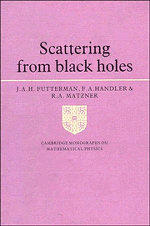Book contents
- Frontmatter
- Contents
- Acknowledgements
- Foreword
- 1 Introduction
- 2 Perturbations of black hole spacetimes
- 3 Integral spin plane waves in black hole spacetimes
- 4 Neutrino plane waves
- 5 Scattering
- 6 Limiting cross sections
- 7 Computation of cross sections
- 8 Absorption, phase shifts and cross sections for gravitational waves
- 9 Conclusion
- Appendix A1 Integrals used to express plane waves in terms of spin-weighted spheroidal functions
- Appendix A2 Addition formulae for spin-weighted spherical angular functions
- Appendix B
- References
- Index
9 - Conclusion
Published online by Cambridge University Press: 04 August 2010
- Frontmatter
- Contents
- Acknowledgements
- Foreword
- 1 Introduction
- 2 Perturbations of black hole spacetimes
- 3 Integral spin plane waves in black hole spacetimes
- 4 Neutrino plane waves
- 5 Scattering
- 6 Limiting cross sections
- 7 Computation of cross sections
- 8 Absorption, phase shifts and cross sections for gravitational waves
- 9 Conclusion
- Appendix A1 Integrals used to express plane waves in terms of spin-weighted spheroidal functions
- Appendix A2 Addition formulae for spin-weighted spherical angular functions
- Appendix B
- References
- Index
Summary
The analysis of scattering by black holes first led us to consider many different formalisms for the wave perturbations in black hole spacetimes. When we had the perturbations in hand, we came against the problem of defining ‘plane waves’ in the long range Newtonian tail of the black-hole gravitational field. The analogy with Newtonian gravity gives the solution to this problem, and the solution to the integer-spin case for low frequencies; both embodied in the natural (Regge & Wheeler, 1957) radial variable r*.
The temptation exists to simply write down a partial sum expansion and allow high-speed computer technology to present you the answer. The results of such an approach are often unintelligible. Hence we were drawn to an extended study of the limiting forms of the cross sections, in the low frequency, in the high frequency, and in the high frequency glory limits. Finally in chapters 7 and 8 we arrive at the computational level, and agreement with the limiting and qualitative results of chapter 6 give us confidence in our result.
What have we profited? We have developed, and develop still, a variety of techniques of perturbation theory. We have learned much about scattering theory, and we have numerical predictions that one day may allow us to measure the inertial mass of a condensed object, perhaps proving the existence of a black hole.
We close with a brief conjecture on the qualitative features of off-axis black hole scattering. We will discuss each of the principal features seen in the scattering cross sections of axially incident gravitational waves: the forward divergence, the orbital dip, and the backward glory.
- Type
- Chapter
- Information
- Scattering from Black Holes , pp. 167 - 169Publisher: Cambridge University PressPrint publication year: 1988

